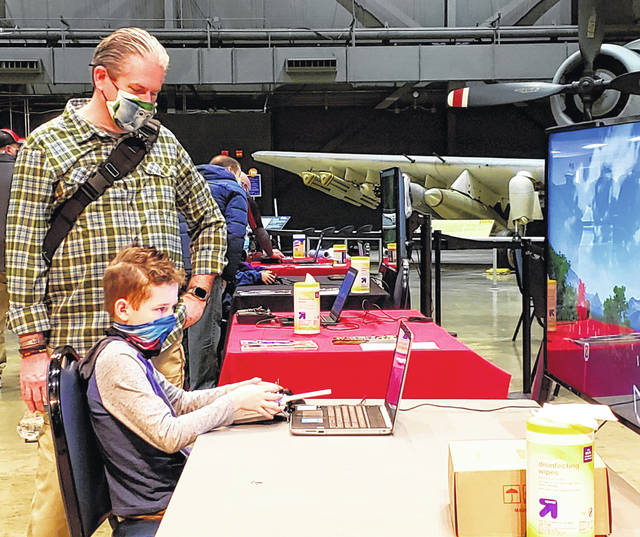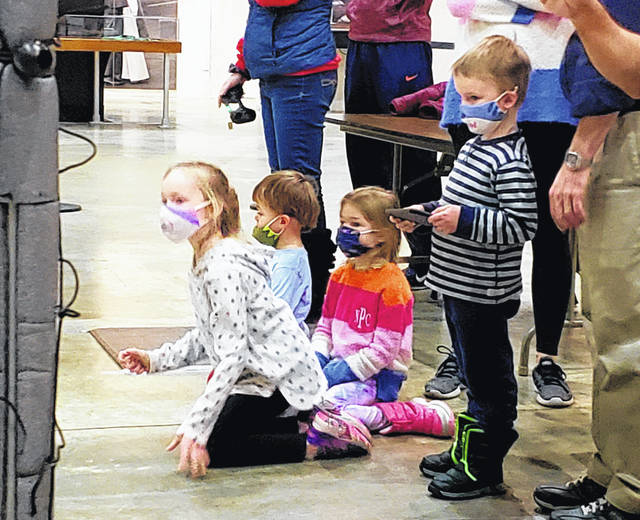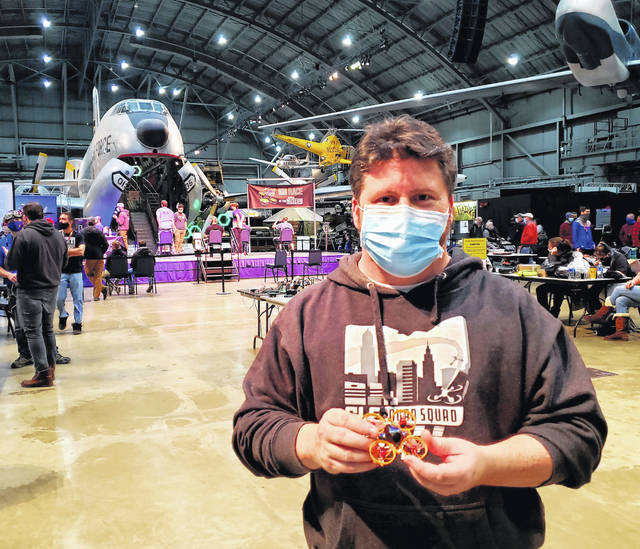


RIVERSIDE — The day starts early for pilots competing in micro drone races. At the National Museum of the United States Air Force, 20 pilots competed in the second annual drone racing event, which according to museum volunteers, drew the largest crowd the place had seen since its post-COVID reopening.
The Cold War Gallery was packed Saturday, as pilots competed in a series of two-minute heats to fly small “Tiny Whoop” drones under, around and through a C-124 Globemaster.
Events like the ones that occurred Saturday are opportunities for the Air Force and other organizations to introduce young people to the world of aerospace technology. Both Sinclair Community College and the Air Force Research Lab had opportunities set up for visitors to pilot their own drones, as well as computer simulations.
“This is one of our STEM outreach events,” said Lt. Col. Dan Kimball, director of operations at AFRL. “We’re trying to get kids excited about aviation.”
Watching the micro drone races Saturday, it was hard not to get excited.
Drone pilot Michael Carroll, who goes by the tag “Av8tr” in the races, had a break between the races to take stock of his drones and share his experience flying them inside the museum. Carroll has been competing in micro drone races for four years, and Saturday, he competed in the second-fastest division. At time of interview he was in fifth place out of eight in the division.
“I’m the old man of the group,” he said. “Most of these guys here are 20 years younger than me, but I take pride in that I hang with the fastest guys.”
Carroll, who is 51, came to the Air Force Museum for the inaugural races with his family last year.
“I have a 12-year old, he and I race together. If it wasn’t for COVID he would be here,” he said.
Carroll and his family are part of the Cleveland Quad Squad, so named in reference to the quad-copter drones that they fly. Members of the CQS compete in the Drone Racing League, which has been broadcast in the past on ESPN.
“We have some of the top pilots in the country on our team,” Carroll said. “We have groups here from Detroit, Cleveland and Cincinnati. We have friendly rivalries but we all respect each other.”
Carroll broke his quadcopter drone in his second heat of the day. Fortunately, he came prepared with a replacement or two.
“You always bring a spare quad to a meet. Usually two or three,” he said.
The new quadcopter was not without its challenges.
“It has a different camera angle that I have to get used to.”
Since the angle of the camera is steeper, Carroll has to tilt the drone faster and farther to get the camera level with his surroundings. The micro drones can go up to 25 miles an hour, while maneuvering around tight spaces, inside the airplane, and through obstacles in the course.
Carroll is a commercial pilot, by trade, having logged 4,000 hours of flight time, and said competing at the Air Force Museum was a highlight.
“It’s such a pleasure to fly here, flying through true aircraft,” Carroll said. “It’s so neat, and it’s neat that I get to experience that with my son.”
Last year, 40 pilots attended the races. Next year, the museum hopes to expand the number of pilots coming to compete.
Outside the realm of competitive races, drone flying has myriad personal and professional uses, the opportunities of which are rapidly expanding.
Sinclair Community College alumnus Sam Heckel has put in more than 1,000 hours flying drones for solar farm inspection, and said that professional Unmanned Aerial Systems operation is seeing career growth in three main areas: agricultural inspection, zoning, and first responders.
“It’s primarily the first two,” Heckel said. “[Police] squads are typically making their own staff UAS operators.”
Sinclair offers both a certification and an associates degree in UAS operation.
The UAS industry has been estimated at $94 billion between 2015 and 2025, according to information provided by the college, with average salaries at $67,000 to $99,000 per year. The industry is expected to generate over 100,000 new jobs in the next 10 years.
In fact, the Air Force is playing a large part in the massive expansion of unmanned aerial vehicles in the United States, according to Dan Kimball, director of Operations for the Air Force Research Lab.
“The Air Force is doing tons of work on drones,” Kimball said. “Unmanned drones are on the cusp of exploding across the nation.”
Visitors to the museum were able to test their skills in drone flying simulators provided by both Sinclair and the AFRL. The simulators range in difficulty from simple fair-weather flying to navigating a craft through a series of simulated rings. As much as drones rely on the technical prowess of aviation engineering, developing intuition and reflex is just as necessary to see success.
“It’s a chance to see how touchy these things are,” Kimball said. “You have to think, ‘how do these things move?’ ”




